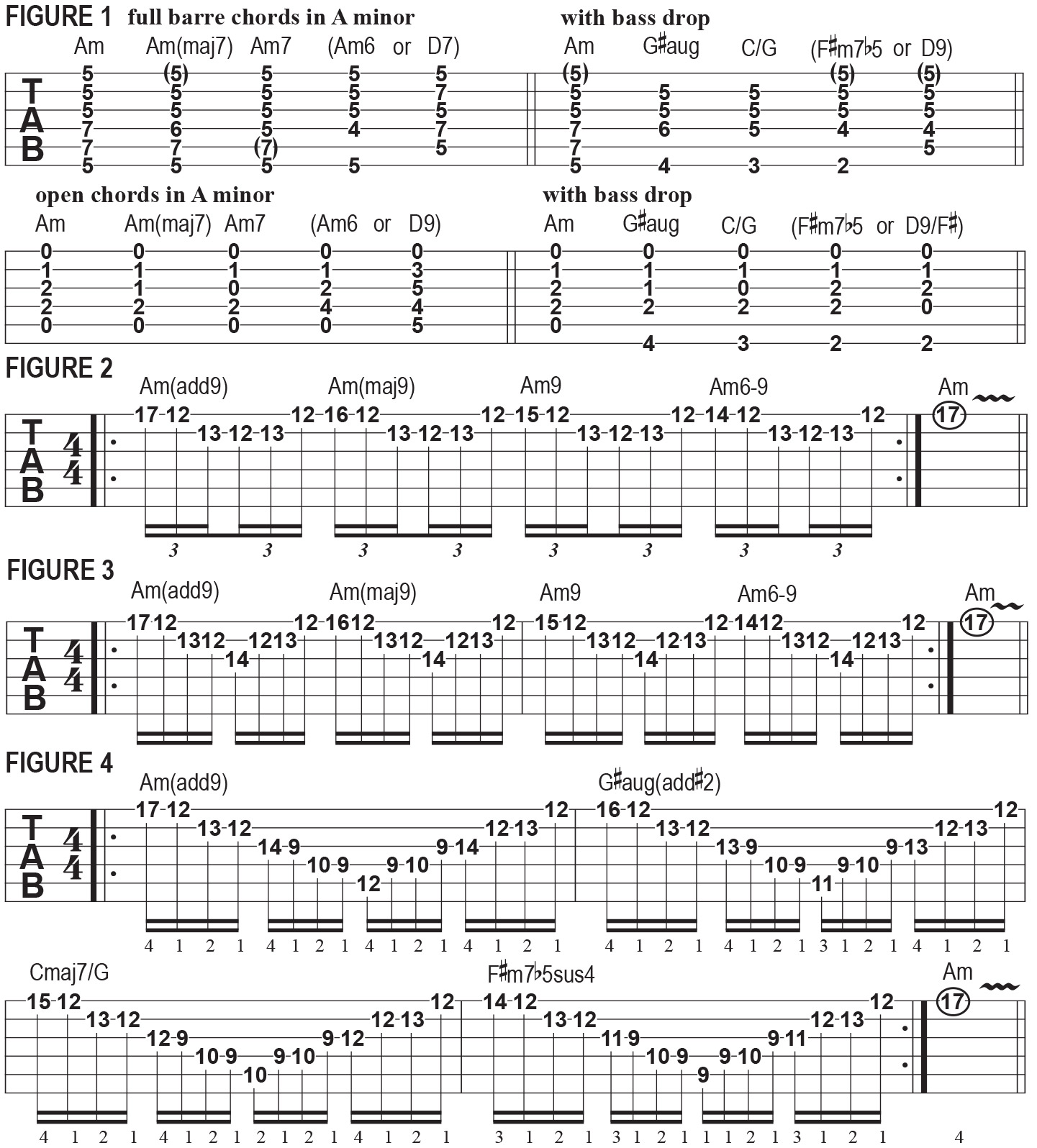Shredding with the Minor-Drop Progression
Using movable and transposable four-note arpeggios to create fun and exciting runs.
I’m going to demonstrate some fun, shred-y ways to play the standard “minor drop” progression, this time as single notes based on four-note arpeggios. The examples are all in the theory-friendly key of A minor and are movable and transposable to other keys, and they’re performed with alternate (down-up) picking.
Each arpeggio includes the second, or ninth, interval, B, added to the underlying triad or seventh chord, which makes for an even, four-note “cell” that lends itself well to picking two notes per string and phrasing with 16th-note or 16th-note-triplet rhythms, as well as to playing the same shape in a lower octave and pair of similarly tuned strings. And since we’ll be playing single notes, they’ll sound good with either a clean or overdriven tone, provided you perform them cleanly.
As a quick review, FIGURE 1 illustrates four sets of chord voicings for the minor-drop progression that I presented previously in the key of A minor. Notice that the first and third sets keep the A bass note as a pedal tone for the first three chords, whereas the second and fourth sets have the root motion following the chromatic drop.
Our first single-note example, FIGURE 2, has us playing 16th-note triplets across the top two strings, starting on a high A note, which then drops chromatically, and pivoting, or “bouncing,” off of the B note on the second string’s 12th fret, which, in the key of A minor, is the added second, or ninth.

FIGURE 3 is a 16th-note variation that adds a low A pedal tone on the G string’s 14th fret, which now serves as our pivot, or “bounce-back,” note. As indicated in both examples, instead of playing the fourth arpeggio, Am6-9, you could alternatively, after playing Am9, backtrack to Am(maj9), by returning to the high G# note at the 16th fret instead of playing F# at the 14th fret. This creates the same kind of intriguing retrograde harmonic movement that, as I mentioned last month, occurs in Stevie Wonder’s “I Just Called to Say I Love You” and “You Should Be Dancing” by the Bee Gees.
FIGURE 4 expands our 16th-note run down into the middle register, by repeating the first four notes an octave lower on the G and D strings, using the same fingering shape, shifted down three frets, before bouncing off the A string and ascending back across the top four strings. Another variation here is that we’re now eliminating the A pedal tone after the initial Am(add9) arpeggio and are applying the minor drop universally to each A note, which makes the run work well with the descending-bassline version of the progression, as there are no clashing A notes. The low F# on the A string’s ninth fret, on beat three of bar 4, and the B note that follows it at the same fret on the D string require a brief barring and rolling of the fret-hand index finger to perform a double-stop. Practice this move slowly at first, striving for a clean articulation, then gradually increase the tempo. Apply pick-hand palm muting to the lower strings to suppress ringing and help keep the notes separate and distinct.
Another option with all three of these single-note runs is to reverse the melodic contour and begin on the lowest note of each sequence instead of the highest, which also makes for a good alternate picking exercise variation.
Try shifting these shapes up or down the fretboard to different tonal centers, such as G minor or E minor. You can also try playing the 16th-note triplet sequence from FIGURE 2 on the middle two or bottom two strings and expand FIGURE 3 to encompass three octaves. Experiment, and throw in an occasional pull-off or hammer-on if you like.
Get The Pick Newsletter
All the latest guitar news, interviews, lessons, reviews, deals and more, direct to your inbox!
Over the past 30 years, Jimmy Brown has built a reputation as one of the world's finest music educators, through his work as a transcriber and Senior Music Editor for Guitar World magazine and Lessons Editor for its sister publication, Guitar Player. In addition to these roles, Jimmy is also a busy working musician, performing regularly in the greater New York City area. Jimmy earned a Bachelor of Music degree in Jazz Studies and Performance and Music Management from William Paterson University in 1989. He is also an experienced private guitar teacher and an accomplished writer.










![Joe Bonamassa [left] wears a deep blue suit and polka-dotted shirt and plays his green refin Strat; the late Irish blues legend Rory Gallagher [right] screams and inflicts some punishment on his heavily worn number one Stratocaster.](https://cdn.mos.cms.futurecdn.net/cw28h7UBcTVfTLs7p7eiLe.jpg)
